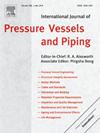Deformation response and microstructure evolution in 304LN stainless steel subjected to multiaxial fatigue loading under different strain paths
IF 3
2区 工程技术
Q2 ENGINEERING, MECHANICAL
International Journal of Pressure Vessels and Piping
Pub Date : 2025-01-31
DOI:10.1016/j.ijpvp.2025.105452
引用次数: 0
Abstract
Axial-torsion low cycle fatigue (LCF) experiments were conducted on 304LN stainless steel under in-phase triangular (IPT), 90° out-of-phase triangular (OPT), 90° out-of-phase sinusoidal (OPS), and 90° out-of-phase trapezoidal (OPZ) loading paths with same applied axial strain () and equivalent shear strain amplitude (), to study the material's cyclic stress response (CSR) under each strain path and to further correlate the responses with dislocation substructure and martensite formation. The CSRs exhibited primary hardening followed by softening and a secondary hardening. Both primary and secondary hardening were found to increase, and the softening was found to decrease as per the following sequence IPT < OPT < OPS < OPZ. Electron backscattered diffraction (EBSD) revealed that both deformation-induced Martensite (DIM) fraction and Kernel average misorientation (KAM) increases in the same sequence for different paths, indicating the tendency of formation of DIM increases and the propensity of recovery decreases in the same order. The cyclic stress response and DIM formation under non-proportional loadings are rationalized by (i) higher non-proportionality of strain path for OPS than OPT for same equivalent strain amplitude, and (ii) greater equivalent strain amplitude in OPZ than OPS. A greater fraction of planes subjected to combined resolved shear and tensile stress under OPS path than OPT path leads to a greater DIM formation in the OPS path than OPT path, reflecting the effect of non-proportionality factor. A greater magnitude of resolved shear and normal strain, and high tensile normal stress causes higher DIM formation and hardening in the OPZ path as compared to OPS path, reflecting the effect of equivalent strain amplitude.
304LN不锈钢在不同应变路径下多轴疲劳加载的变形响应与组织演变
在相同轴向应变(ε)和等效剪切应变幅(γ3)下,对304LN不锈钢进行了同相三角形(IPT)、90°异相三角形(OPT)、90°异相正弦(OPS)和90°异相梯形(OPZ)加载路径下的轴向扭转低周疲劳(LCF)试验,研究了各应变路径下材料的循环应力响应(CSR),并进一步将响应与位错亚结构和马氏体形成联系起来。CSRs表现为一次硬化,其次是软化和二次硬化。按照IPT <的顺序,一次硬化和二次硬化都增加了,而软化则减少了;选择& lt;运维& lt;OPZ。电子背散射衍射(EBSD)结果表明,形变诱导马氏体(DIM)分数和核平均错取向(KAM)分数在不同路径下增加的顺序相同,表明DIM的形成倾向增加,恢复倾向减少的顺序相同。非比例加载下的循环应力响应和DIM形成可以通过(i)在相同等效应变幅下,OPS应变路径的非比例性高于OPT, (ii) OPZ的等效应变幅大于OPS。由于OPS路径下受分解剪应力和拉应力联合作用的面比OPT路径下大,导致OPS路径下的DIM形成比OPT路径下大,反映了非比例因子的影响。相比于OPS路径,更大的分解剪切应变和法向应变大小以及较高的拉伸法向应力导致OPZ路径中更高的DIM形成和硬化,反映了等效应变幅值的影响。
本文章由计算机程序翻译,如有差异,请以英文原文为准。
求助全文
约1分钟内获得全文
求助全文
来源期刊
CiteScore
5.30
自引率
13.30%
发文量
208
审稿时长
17 months
期刊介绍:
Pressure vessel engineering technology is of importance in many branches of industry. This journal publishes the latest research results and related information on all its associated aspects, with particular emphasis on the structural integrity assessment, maintenance and life extension of pressurised process engineering plants.
The anticipated coverage of the International Journal of Pressure Vessels and Piping ranges from simple mass-produced pressure vessels to large custom-built vessels and tanks. Pressure vessels technology is a developing field, and contributions on the following topics will therefore be welcome:
• Pressure vessel engineering
• Structural integrity assessment
• Design methods
• Codes and standards
• Fabrication and welding
• Materials properties requirements
• Inspection and quality management
• Maintenance and life extension
• Ageing and environmental effects
• Life management
Of particular importance are papers covering aspects of significant practical application which could lead to major improvements in economy, reliability and useful life. While most accepted papers represent the results of original applied research, critical reviews of topical interest by world-leading experts will also appear from time to time.
International Journal of Pressure Vessels and Piping is indispensable reading for engineering professionals involved in the energy, petrochemicals, process plant, transport, aerospace and related industries; for manufacturers of pressure vessels and ancillary equipment; and for academics pursuing research in these areas.

 求助内容:
求助内容: 应助结果提醒方式:
应助结果提醒方式:


